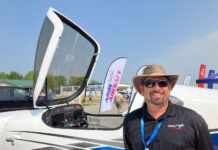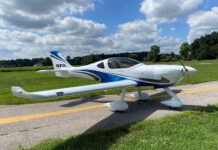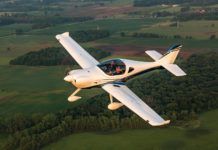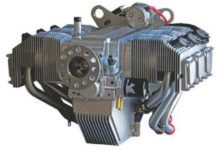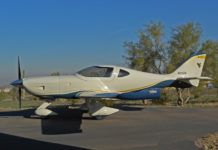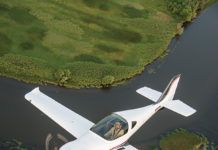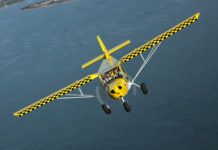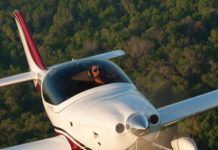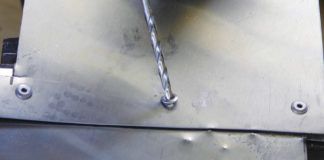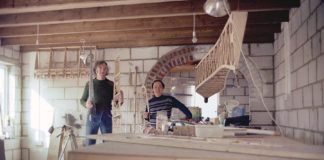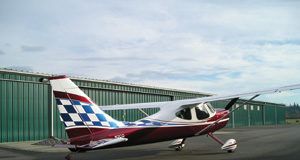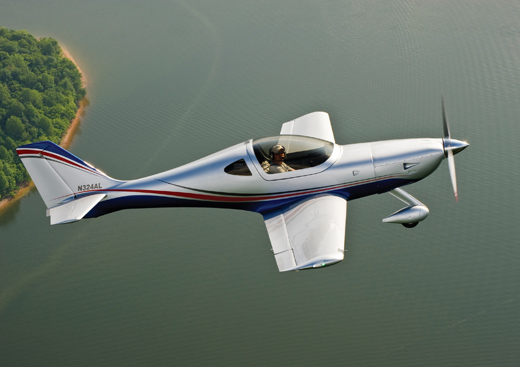
A request from the editor of this magazine to strike out to Shelbyville, Tennessee, and fly the Arion Lightning was just what I needed to skip a day or two riding my bicycle or mowing the lawn. Shelbyville is within easy range of my RV-3, and a new airplane is what test pilots live for—in other words, a great excuse to fly to go flying.
Having spent some time reviewing the Arion web site I was looking forward to learning if the Lightning flew as well as it looked. The Lightning is a slick little two-seater whose wing has what I’d call a comfortable wing aspect ratio with three-quarter-span flaps and ailerons mounted outboard of the flaps. The fuselage provides a good length for the tail feathers to operate on; the horizontal fin and elevator might, to my eye, be a little small relative to the wing, but the vertical fin and rudder size particularly appealed to me.
Like several Light Sport aircraft these days, the Lightning is powered by the 120-horsepower, six-cylinder Jabiru 3300. Designer Nick Otterback thinks the plane could be modified to meet LSA requirements. The maximum gross weight would have to be lowered to 1320 pounds, and at that weight it could meet the LSA stall speed (clean) requirement of 45 knots CAS. To keep from exceeding the maximum level speed for LSA—120 knots CAS at sea level with maximum continuous power—the propeller, either a fixed-pitch or ground-adjustable Sensenich, would have to be carefully chosen.
Meeting the Plane
I arrived to meet Otterback at the Arion hangar, and he introduced me to the first Lightning demonstrator, N323AL, which is an exceptionally nice looking airplane with outstanding workmanship. It looked better in person than I expected; the photos don’t do it justice. (The airplane you see on these pages is the second prototype.)
The control surfaces offered little friction in the elevator system, though the trim bungees were detectable. I was surprised to find some friction in the ailerons, as they are pushrod operated like the elevators, and such systems generally have little friction. Control friction, obvious on the ground, can be overcome by aerodynamic hinge moments and not be noticeable in flight. We’d see. Rudder friction and forces seemed normal.
Otterback had just removed the Sensenich ground-adjustable composite prop and mounted a Sensenich wood fixed-pitch design that provides more cruise speed. It’s also 6 pounds lighter than the ground-adjustable, which has a metal hub and retention system.
Estimated takeoff weight was 1325 pounds for the first flight—where Otterback would demonstrate basic flight maneuvers, and offer insight on power settings and speeds for my later flight. Takeoff weight was 1375 pounds for the second flight, which included more fuel, balanced at 11 gallons in each main tank. The c.g. positions were calculated at 34 and 35 inches, respectively. Max gross weight is 1425 pounds, and the c.g. range is 29.0 to 36.5 inches aft of the firewall datum. We estimated baggage (behind the seats) at less than 10 pounds. Both flights would be comfortably under max gross and just ahead of the aft-c.g. limit.
Climbing In
The cockpit was well laid out with Grand Rapids displays on both sides of the panel and “steam gauges” as backups. There were full dual controls, which included adjustable rudder pedals (I would later rue not taking full advantage of those thoughtful additions) with toe brakes; a single throttle control is at mid panel.
The side-by-side seats were well placed, and with padding to provide minimum head clearance from the canopy, visibility was adequate over the nose. The seat reclining angle is typical of these slick low-drag fuselage designs—comfortable but not exactly upright. A check for control motion showed that the lateral stick displacements for roll fit nicely from knee to knee. There was no aileron trim in this demonstrator, but Otterback said some customers had added it.
Stick motion for pitch was about 50% more than roll and covered a good bit of the space from the panel to seat belt. The trim bungees’ feel was evident, and with this system the stick moves in pitch as the electric pitch trim is applied.
Otterback made the takeoff and went through the program we had discussed. He described cockpit procedures, power settings and airspeeds for the various configuration changes and special techniques required. His normal landing made it look deceptively easy.
The Test Pilot’s Turn
The Jabiru engine starts just like a car: choke out if a cold start, turn the key and instant ignition. Taxi is straightforward with effective rudder control and occasional use of toe brakes. It soon became apparent that with each rudder application I was also getting some undesired braking. I should have accepted Otterback’s offer to adjust the rudder pedals.
For takeoff, Otterback recommended the trim be set with the stick centered for takeoff, and the flaps set at 10°. The full-throttle power response and roll acceleration were similar to many GA airplanes—not as sporty as some of the RV series, but positive for an airplane with a fixed-pitch propeller. Typical right rudder inputs maintained the centerline on the initial roll and lessened as speed increased.
At 40 mph, I applied a pitch input for rotation to the takeoff attitude. From the demo flight I knew pitch forces were light, but I was still surprised by the rapid nose-up pitch to about 10°. Thinking the trim setting could be the problem, I applied some nose-down trim. As the trim and flap buttons are both on top of the stick, and they’re identical in shape, I managed to hit both while trying to damp the PIO and raised the flaps as well. After a few diminishing cycles the situation was under control, and Otterback’s body language relaxed considerably. Trim was not the problem. I now knew that takeoff rotation in this airplane, at least as currently loaded, must be made gently.
For climb speed Otterback suggested the best rate figure of 100 mph. Full throttle at this speed resulted in 2500 rpm and a climb rate of 800 to 1000 fpm. At this speed good visibility over the nose required slight S turns.
Steeper S turns made the reduced control harmony more apparent. Stability checks during the climb indicated slightly negative static stability in pitch. The symptoms were classic—light pitch forces, inability to trim for a speed and the nose staying pretty much wherever placed without re-trimming. The Lightning was controllable in pitch, but required a high workload to achieve the desired precision. Before you jump to conclusions and accuse me of over-analyzing this point, hang on; there is more to the story.
Cruise Flight
We leveled at 5000 feet MSL (OAT 10° C) where 2950 rpm gave us an impressive 150 mph IAS, calculating out to 163 mph/142 knots TAS. (That’s close, but not quite up to the claimed 170-mph cruise.) I noticed we hadn’t changed the pitch trim from the 100-mph climb setting, and the airplane was happy there at 150 mph. Pitch stability improved at this higher speed, as the pitch force per G was up to 2 to 3 pounds, indicating some damping. Other indications of low static pitch stability were the gust response of the airplane (heaving rather than pitching) and the “digging in” feel of pitch response to control inputs. Lateral/directional stability was still good at this higher speed, and adverse yaw was less apparent, but still required some rudder coordination with roll inputs.
Stalling, Stalling
There was adequate warning of the unaccelerated stall, which occurred at 55 to 60 mph IAS with the flaps up. The stall break was down and slightly to the left. Normal recovery technique (slight forward pitch input) sufficed. Accelerated stalls, left or right, broke left. Normal recovery technique (reduced back pressure) was successful.
At about this time, some 15 to 20 minutes into the flight, I was beginning to notice an out of trim condition in roll to the left. We hadn’t switched tanks since takeoff and should have. This could have caused the left roll in the stalls. With wing tanks and no roll trim capability, the fuel tank selector valve becomes part of the control system. Mea culpa.
Slow flight at 70 mph IAS required about 2200 rpm for level flight. The aircraft was a little more divergent in pitch, and stick force per G was now near zero. Accelerated stalls were not attempted due to the light pitch forces.
Descent back to SYI and into the landing pattern was uneventful. Final approach, pre-flare and final flare tasks were dominated by the light pitch forces. Power management was straightforward, allowing good sink rate control for touchdown and minimization of pitch inputs.
The first landing had a low sink rate and was fairly well lined up, but I touched down with too much right rudder. It was a combination of sight picture (too much recent time sitting centerline), not having the rudders adjusted properly (my fault), being rather busy with the flare business (not all my fault), and just not being good enough to do it all at once (definitely my fault). The second landing was better, but there was still some right rudder that didn’t have to be there. The third landing was OK.
On all of the landings stick activity became greater the closer we got to the ground. I was working much harder than should be required to achieve a normal landing, on centerline, in the first third of the runway, on a bright VFR day with light winds.
The Debrief
Otterback and I found a quiet place and discussed the flight. During our dialogue he was receptive to comments, even when they weren’t what he’d hoped to hear. The primary problem I saw with the demonstrator was static instability, probably caused by an aft c.g. The light pitch forces were likely caused by this and perhaps by the pitch stick-to-elevator gearing (too much leverage between the stick and elevator). Based on what I’d seen on this flight, I suggested the aft-c.g. limit should come forward.
Otterback said he was working on the c.g. problem and felt the slightly heavier ground-adjustable prop and a larger battery on the firewall would make some immediate improvements. He mentioned that newer tail components were a few pounds lighter than those we flew.
He also said some of the customer aircraft probably had slightly more forward c.g. locations. Reviewing the Arion web site, I found a flight report written by Buz Rich, who has flown his Esqual for some 400 hours. The Esqual is a Spanish design that was a predecessor to the Lightning and has similar flight characteristics. Rich had a career in the U.S. Air Force with an impressive flying background, and has flown a number of Lightnings, including at least one first flight. He has flown the Lightning prototype and the demonstrator I’d flown.
I contacted Rich, and we discussed his experience in the Lightning as well as the details of my flight. He listened patiently to my concerns, and replied that he was high on the airplane and liked it just the way it was. I mentioned an interest in flying a customer Lightning with a more forward c.g. He had done the first flight in such an aircraft based just 20 miles from him in Wakefield, Virginia (KAKQ). It had more avionics than the demonstrator and an autopilot, and should have a more forward c.g. The owners, Linda and Joe Mathias, graciously agreed to let Rich and I fly their airplane.
Rich educated me on the bungee elevator trim system common to the two aircraft. We agreed a traditional elevator trimtab system might be an improvement. I thought it could be a contributor, but was still concerned about the c.g. location. I hoped this flight would shed some light on the subject.
I won’t recount the entire flight here, but the summation is this: The Mathias airplane flew almost exactly like Otterback’s demonstrator. It was flown at a calculated c.g. 1 inch further forward (33.8 inches) than the demonstrator, and some 35 pounds heavier. I saw no difference between the two aircraft in the various flight regimes tested. The results from stick-free and stick-fixed stability checks were the same for both methods, which indicated the bungee system was not exacerbating the stability problem.
A Reunion, of Sorts
After these flights, I was convinced that the Lightning could have excellent flying qualities to match its performance and overall design. Some seven months after my first encounter, I met again with Otterback. He was flying to my (red) neck of the woods to give me a look at his new demonstrator, N324AL, which had just won a best composite award at Sun ’n Fun.
Otterback listed the changes incorporated in N324AL. He had moved as many items as possible forward for firewall mounting; the tail was lighter; the engine had been moved forward 1 inch with a new mount; and fuel capacity had increased to 30 gallons. More important: The elevator gearing had been changed to increase stick forces; in place of the pitch-trim bungees was a trimtab on the elevator; and the aft-c.g. limit had been moved forward to 35 inches from 36.5.
On the walk-around Otterback pointed out the conventional elevator trimtab, and I noticed some unbalance (trailing edge heavy) in the elevator that wasn’t apparent with the bungee system. This would increase steady-state pitch stick force per G to some extent. The roll and rudder control systems had not been changed, and the friction in the aileron system was still there.
Happy Ending?
Otterback had done a good job balancing fuel on his trip down, so we had about 12 gallons in each tank. With two of us aboard our gross weight was 1400 pounds, with the c.g. at 34.9 inches (aft limit 35.0). We were near max gross and the aft limit, which was the condition I wanted to investigate.
The takeoff was a non-event. I under rotated at first (the takeoff and touchdown attitude looked higher than I remembered) and drifted slightly left (downwind) on the initial phase. None of this was the airplane’s fault. The interesting thing was that I under controlled instead of over controlling as before.
There was no problem holding 100 mph in the climb, and pitch trim response was normal. There was positive longitudinal static stability, and some dynamic checks verified a satisfactory level of stability. Pitch stick force per G was greater than 3 pounds, and the relatively higher roll forces were not as noticeable. Closed loop pitch-pointing tasks showed good response and precision. Turbulence response wasn’t a factor in the climb from a control standpoint, though light wing loading is always good for some jolts.
We leveled off at 5000 feet MSL.
Pitch stability checks indicated a good level of positive static and dynamic longitudinal stability. Trim response was good, and all closed loop tasks—heading and altitude control during maneuvering, and pitch pointing, for example—required normal pilot workload. Pitch stick force per G was about 4 pounds.
A speed check was performed with power set at 3000 rpm, indicating 140 mph at 5000 feet where the temperature was 15° C. Two GPS runs resulted in a true airspeed of 153 mph (136 knots), which matched the TAS on the Grand Rapids display. Still at 5000 feet, we slowed to 100 mph IAS to lower the first 10° of flap, and the deceleration continued to a 30° full flap configuration at 70 mph IAS. There wasn’t enough nose-up trim authority to allow hands-off flight at 70 mph IAS, but that wasn’t a problem, and would ensure monotonic pitch stick forces in the landing flare. (Engineers take note: Test pilots aren’t as dumb as you think.)
In the landing configuration, all flight tasks required normal pilot workload—no problem making aggressive steep turns at speeds a few mph above stall with prudent use of power. Stalls occurred at the same speeds (55 to 60 mph IAS, flaps up; 45 to 50 mph with flaps at 30°) as before, with some warning prior to a sharp break. We recovered with normal technique.
The first landing was made from a purposeful high start (just to stir the pot). There was predictable response to control inputs, and touchdown was at the desired place on the runway with good touchdown parameters. Rollout was made to a full stop, and rollout control was satisfactory in the 6- to 8-knot crosswind. On the second landing we were lucky and got a good jolt on short final, which required rapid roll and pitch inputs. The response was positive, predictable and controllable, with the desired touchdown parameters. I felt comfortable making moderately aggressive inputs in this airplane.
Closing Comments
A primary goal of all test pilots, and some writers, is to remain objective. We try to keep personal opinions and emotion out of the work. In this case, though, it was difficult to remain completely neutral. Nick Otterback had a product that had been successfully completed and flown by some 26 customers, and there were 63 aircraft under construction. Then someone comes along and tells him the beautiful little airplane he has spent money, blood, sweat and tears developing has some serious problems in spite of reported customer satisfaction. The typical response is for someone to dig in his heels and take the position that it flies, customers are buying it, they like it, and “I’m not changing a thing.” This may suffice if no certification process is in the works, and most homebuilts never get to that point.
Otterback took another approach. He began a process of improving the stability of his airplane in purposeful, measured steps. A little here, a little there and, finally, without major modification, he succeeded in making the Lightning a safer, more pleasant airplane to fly—without compromising performance. In this effort Otterback and Arion Aircraft demonstrated a level of professionalism that is commendable and reflects well on the homebuilt industry.
For more information, call 931-680-1781, or visit www.arionaircraft.com.

